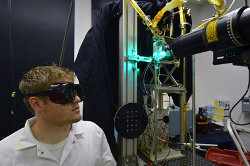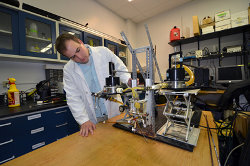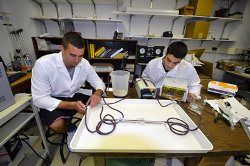Heart Lab Research
Dr. Keefe Manning's research group focuses on understanding the fluid mechanics of the cardiovascular system in native and diseased states. In addition, Dr. Manning has an interest in the impact of cardiovascular prosthetic devices. Currently, his lab is focusing on three main projects: investigating the impact of HeartMate II on a three-dimensional flow field, developing a pediatric ventricular assist device, and analyzing thrombi growth.
HeartMate II

Patients who have received a HeartMate II (HMII) left ventricular assist device are at an elevated risk for Acquired von Willebrand Syndrome, which occurs when a glycoprotein in the coagulation cascade is cleaved by high shear stresses. In this project, a laser Doppler velocimetry (LDV) system is used to quantify the three-dimensional flow field in the outlet cannula of a HMII so the Reynolds stresses can be calculated. LDV utilizes the Doppler effect to calculate the velocities of tiny glass particles that are seeded in the test fluid, which is a non-Newtonian blood analog in this case. The HMII is incorporated into a flow loop which includes tubing, a compliance chamber, a resistive element, and a pulsatile pump. A range of physiologically relevant pressures and flow rates are used to analyze the potential blood damage caused by the HMII at numerous levels of left ventricular function.
Pediatric Ventricular Assist Device

Scaling down adult ventricular assist devices for pediatric patients has been an active area of research for some time. In vitro experiments are being performed to aid in the ongoing development of the Penn State Pediatric Ventricular Assist Device (PVAD). The flow visualization technique particle image velocimetry (PIV) is being used to quantify the flow field within the PVAD. A non-Newtonian blood analog fluid is seeded with small glass beads to allow for flow visualization, and velocity patterns and regions of low wall shear rate, which are consistent with thrombus deposition, are of particular interest. Currently, experiments are being performed to study the impact of an active ventricle on the flow through the PVAD.
Thrombus Growth

Bovine blood is circulated through a flow loop containing a backward-facing step (i.e. an asymmetric sudden expansion) for varying lengths of time. A recirculation region, which is physiologically relevant in the context of some cardiac devices, forms downstream of the step and facilitates thrombus (blood clot) formation. The resulting thrombi are analyzed both with histology sectioning and magnetic resonance imaging (MRI). Histology sectioning allows the cellular components of the thrombus to be analyzed, while the MRI data allows computational fluid dynamics simulations to be executed on realistic thrombus geometries to investigate velocity patterns near, and shear stresses on, the thrombi surfaces. This project will aid in our understanding of how fluid mechanics affects both the composition and size of thrombi formed in recirculation regions. We are working on a computational thrombosis model to predict thrombus growth in recirculation regions and will use the MRI data set as validation for our thrombus growth simulations.
- Josh Taylor and Erin Richards, doctoral students in biomedical engineering

